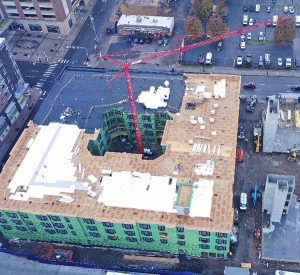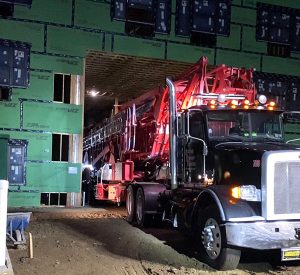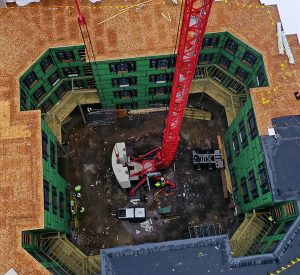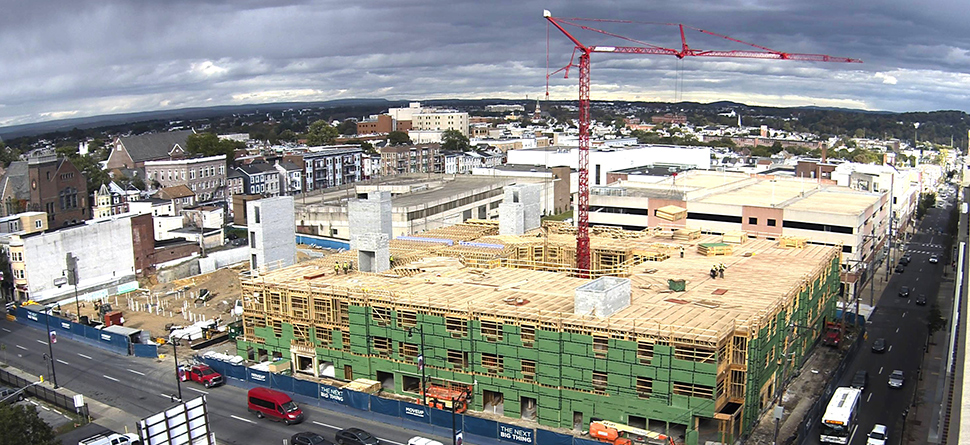Thank you for your interest in Potain self-erecting tower cranes.
Please fill out the form below and a crane expert will contact in 1-3 business days.
We use cookies on our website to give you the most relevant experience by remembering your preferences and repeat visits. By clicking “Accept”, you consent to the use of ALL the cookies. To learn more view our cookie policy.
Pennsylvania Contractor Unlocks Productivity with Potain Igo T 130 on Unconventional Build
At a four-story construction site in downtown Allentown, Pennsylvania, a Potain tower crane appears encased inside the courtyard of the complex it is erecting. It’s an engineering illusion that depicts how contractor Quality Buildings uses self-erecting cranes to reimagine its entire building process.
Allentown is an hour drive from Philadelphia and was popularized by the Billy Joel song about the fall of the region’s steel industry. Four decades later, Allentown has rebounded as a manufacturing and tech hub, and is one of the fastest growing cities in Pennsylvania and in the U.S.

Photo provided by: www.citycenterallentown.com
The Hive Residences is a 256-unit apartment complex that will comprise two identical properties with multi-family units and retail space. It is classed as an urban “infill” project that aims to reduce urban sprawl by redeveloping vacant land within an existing neighborhood. The project’s design and location in the city’s historic district posed challenges to traditional stick-build contractors. Quality Buildings was selected as the subcontractor for framing, largely due to one equipment choice it factored into its estimate: a Potain Igo T 130 self-erecting tower crane.
“There really was no other piece of equipment that would work,” said Elmer Zook, president at Quality Buildings. “With the tight jobsite environment and the limited laydown space for supplies, we erected the tower crane in the middle of the building. That allows us to service the entire construction site from a single location. We can offload supplies from trucks parked along the street and place at the exact location on the building where it is needed.”
Quality Buildings, based in Lancaster, Pennsylvania, supplies a turnkey framing package, including pre-fabricated wall panels, and roof and floor trusses. The addition of self-erecting tower cranes to its equipment fleet has transformed the way the company approaches new projects.
Managing the laydown area on a jobsite can become a major obstacle to an efficient project. The limited space and jostling among subcontractors can create bottlenecks and generate inefficiency. Quality Buildings realized that a self-erecting tower crane was the linchpin that would overhaul its entire workflow. The company ceased stick-building and now pre-fabricates wall, truss and roof components at its offsite workshop. Each bundle is numbered, and the kits are transported to the jobsite ready for placement by the Potain crane. Zook estimates they can complete jobs up to 30% faster with about 25% fewer laborers versus traditional stick-building methods.
Small footprint, big reach

The economics of a self-erecting tower crane are justified by its capabilities, transport and setup.
For this project, Quality Buildings is using an Igo T 130. The crane is lifting frame wall bundles that are 3.6 m x 2.4 m x 2.7 m (12 ft x 8 ft x 9 ft) to a height of four stories, each weighing over 1,360 kg (3,000 lbs) per bundle.
“A conventional telehandler can work up to three stories, but above that it’s super hard to manage that amount of height and weight. Another advantage with the Potain is that its broad reach means the material can be placed specifically where it needs to be on the floor, rather than parked on the edge then manually moved,” Zook said. “The self-erectors are also a much less costly solution than using a top-slewing tower crane, especially for small to mid-size contractors.”
The Igo T 130 is Potain’s largest self-erecting tower crane, but still maintains a trim 4.5 m2 (16.4 ft2) footprint. The crane can telescope to 38.5 m (126.3 ft), with variable jib configurations and a maximum capacity of 8 t (8.8 USt).
Quality Buildings took advantage of the crane’s easy transportability on a single trailer with foldable jib. Working lockstep with project engineers, it purposely left one 3.6 m (12 ft) wide archway exit from the courtyard unfinished. They slid the disassembled crane through this archway once construction was complete on the upper floors.
“The structural engineers designed girder trusses to span the opening and that allowed us to build above the archway,” Zook said.
This meant the crane did not need to be repositioned and freed up room around the perimeter.
A greener, more efficient way to build

These time and cost savings are the brilliance of a Potain self-erector, says Chad Jacobs, tower crane specialist with local Potain dealer Stephenson Equipment. While North America is still slow to adopt self-erecting towers, the climate is shifting due to intensified labor shortages and project backlogs.
“A self-erector is not for every single job. A contractor needs to understand how it will work best for their operations and how to factor rental or purchase costs into its estimates,” he said. “It’s a mindset shift for contractors.”
For example, instead of procuring rental equipment a week ahead of a project start, planning needs to start six or seven months in advance at the bidding stage. Adding a Potain makes contractors re-evaluate their wheelhouse, and in the case of Quality Buildings, retool processes and allow it to confidently seek larger projects than it otherwise would have. Jacobs works one-to-one with his tower customers to plan bids and jobs to deliver the best return on their investment. Zook finds the partnership his company has had with Jacobs and Stephenson over the past four years to be invaluable. The Potain self-erecting cranes have opened additional revenue streams for Quality Buildings, too, including renting the crane to other subcontractors on site to set stair towers, decking and light gauge steel.
As sustainable, green construction takes a higher priority for developers, self-erecting cranes are another tool in the contractor’s belt. In residential and urban areas, the Potain’s quiet operation and all-electric power are welcome contrasts to the fumes, noise and disruption of other diesel-powered equipment.
“You have to know what problem you are trying to solve,” Zook said. “This is not a one-size-fits-all product, but for specific projects, there are not many other types of lifting equipment that can get the job done as easily as a Potain self-erecting tower crane.”
